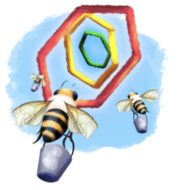Storytelling Boxes: Applying our Lessons Learned
As one of the lead instructors for the Storytelling Boxes project, I wanted to revisit some of my lessons learned from the first cohort (fall 2022) to see how well they applied with the second cohort (spring 2023).
In both cases, a number of libraries from around the country joined us to explore “storytelling boxes.” Our focus was on libraries with makerspaces or a maker/builder orientation.

Original Lesson #1: “Lean into content specificity to find the fun.” Start with a very small, curated set of content that connects thematically or narratively.
Results This Time: Mixed. Our advice was at least partly heeded to focus on smaller and more specific content. More box teams chose content that connected to existing initiatives that were happening within the library. These initiatives included summer reading programs and historical society events. But this shift didn’t necessarily make it easier to find the “fun” to design an activity.
On the plus side, the alignment with existing initiatives created harder launch deadlines for box projects and helped to drive the momentum of work. However, such projects often appeared a bit less playful – perhaps because they felt they couldn’t invent as freely when aligning to an existing and visible initiative.
Amendment: We might rephrase our original advice to specifically recommend surprising, strange or delightful content – even if it’s a bit aside the traditional “most important” character or the usual starting point in the story. Similar to suspending disbelief (or the “magic circle” of games), the fun may require stepping back from the core content – even as we borrow the due dates and audience of larger event programming.

Original Lesson #2: “Bite-sized fun works better for a broad audience.” Be the TikTok of experiences; short, sweet, and to the point.
Results This Time: We encouraged box teams to keep the experiences short and the interactions sharp (nothing that would make a participant wonder when the experience would end). This approach helped teams to find the rhythm of interaction in their projects. One participant described the feeling like playing music; there’s a cadence to the way the interaction progresses and it’s about finding a rhythm that is easy for “listeners” to pick up and follow along. The lesson seems to be helping.

Original Lesson #3: “Don’t be afraid to pivot an experience in a way that removes distracting elements.” When one door closes, a new one opens. Do so without fear.
Results This Time: Our advice to stay brave and pivot seemed to help to give box teams the confidence and security to say “no”. Pivoting and narrowing in requires making choices, and in this way it is different than brainstorming where the “yes-and” approach is needed. Both are essential, and we continue to think that many libraries need some coaching to bravely say no and to make design choices.

Original Lesson #4: “Expect to create something with your current level of technological knowledge (or just beyond).” Time is limited – expect to sharpen existing technology skills through practice instead of learning new skills.
Results This Time: This time we strongly emphasized the most basic box technology (an interactive version of Google Slides) rather than the range we offered last time (including Scratch). Once again, some of our libraries insisted, including to learn Scratch on their own. But in the spirit of Occam’s Razor, the simplest technology is often the right one – and we largely felt the results validated our push to keep the tech simple. Our participants kept underestimating the number of components in a basic storytelling box (tech, physical installation, print materials, etc.). This approach is especially important if there is a launch deadline.
